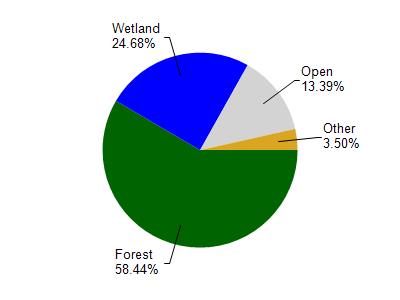Oneida
No
No
No
Fish and Aquatic Life
Overview
Columbus Lake, T39N, R10E, Section 28 Surface Acres = 670.4, S.D.F. = 1.16, Maximum Depth = 26 feet A soft water drainage lake having acid light brown water of low transparency. Sand is the chief littoral material (80 percent) with a significant area of muck present. Upland shoreline is dominant (60 percent) with a significant portion wetland bog including some shrub and conifers. Muskellunge, northern pike, walleye, largemouth bass, smallmouth bass, perch, bluegill, crappie, rock bass, pumpkinseed and sucker are fish species found in this lake. The only means of public access is by navigable water or the wilderness type. Two resorts, a boat rental and 23 dwellings are found on the shoreline. Mallard and black duck use the lake as a nesting site. Puddle ducks, diving ducks and Canadian geese utilize this lake on their fall migrations.
Date
Author Aquatic Biologist
Condition
Wisconsin has over 84,000 miles of streams, 15,000 lakes and milllions of acres of wetlands. Assessing the condition of this vast amount of water is challenging. The state's water monitoring program uses a media-based, cross-program approach to analyze water condition. An updated monitoring strategy (2015-2020) is now available. Compliance with Clean Water Act fishable, swimmable standards are located in the Executive Summary of Water Condition in 2018. See also the 'monitoring and projects' tab.
Reports
Management Goals
Wisconsin's Water Quality Standards provide qualitative and quantitative goals for waters that are protective of Fishable, Swimmable conditions [Learn more]. Waters that do not meet water quality standards are considered impaired and restoration actions are planned and carried out until the water is once again fishable and swimmable
Management goals can include creation or implementation of a Total Maximum Daily Load analysis, a Nine Key Element Plan, or other restoration work, education and outreach and more. If specific recommendations exist for this water, they will be displayed below online.
Monitoring
Monitoring the condition of a river, stream, or lake includes gathering physical, chemical, biological, and habitat data. Comprehensive studies often gather all these parameters in great detail, while lighter assessment events will involve sampling physical, chemical and biological data such as macroinvertebrates. Aquatic macroinvertebrates and fish communities integrate watershed or catchment condition, providing great insight into overall ecosystem health. Chemical and habitat parameters tell researchers more about human induced problems including contaminated runoff, point source dischargers, or habitat issues that foster or limit the potential of aquatic communities to thrive in a given area. Wisconsin's Water Monitoring Strategy was recenty updated.
Grants and Management Projects
| Project Name (Click for Details) | Year Started |
|---|
|
|
Monitoring Projects
| WBIC | Official Waterbody Name | Station ID | Station Name | Earliest Fieldwork Date | Latest Fieldwork Date | View Station | View Data |
|---|
| 1616900 | Columbus Lake | 10004593 | Columbus Lake | 5/11/1996 | 9/30/2017 | Map | Data |
| 1616900 | Columbus Lake | 443076 | Columbus Lake - Deep Hole | 7/9/1979 | 8/26/1996 | Map | Data |
|

Watershed Characteristics
Columbus Lake is located in the Sugar Camp Creek watershed which is 187.99 mi². Land use in the watershed is primarily forest (58.50%), wetland (24.70%) and a mix of open (13.40%) and other uses (3.50%). This watershed has 123.61 stream miles, 11,669.73 lake acres and 30,139.17 wetland acres.
Nonpoint Source Characteristics
This watershed is ranked Not Ranked for runoff impacts on streams, Medium for runoff impacts on lakes and Low for runoff impacts on groundwater and therefore has an overall rank of Low. This value can be used in ranking the watershed or individual waterbodies for grant funding under state and county programs.However, all waters are affected by diffuse pollutant sources regardless of initial water quality. Applications for specific runoff projects under state or county grant programs may be pursued. For more information, go to surface water program grants.